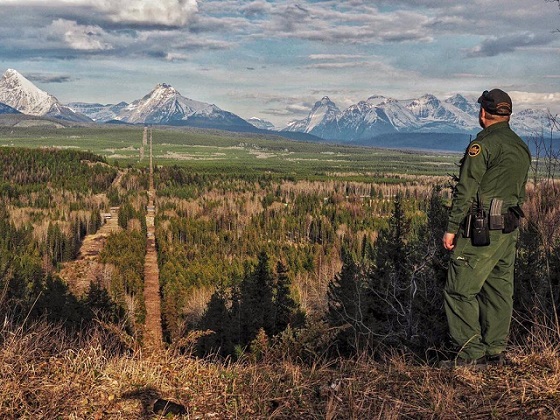Business
Trump declares national emergency at northern border

A Border Patrol agent standing watch at the Montana-Canada border in the CBP Spokane Sector. The Spokane Sector covers the U.S.-Canada border along the northwestern section of Montana, part of Idaho, and the eastern part of Washington. Photo from
From The Center Square
By
Cites smuggling, national security threats
President Donald Trump on Saturday declared a national emergency at the U.S.-Canada border, citing an influx of human and drug smuggling coming from Canada presenting a national security threat to Americans.
He did so after a record number of illegal border crossers were reported entering the U.S. from Canada, the greatest number of known or suspected terrorists were apprehended coming from Canada, and northern border terrorist arrests soared under the Biden and Trudeau administrations, The Center Square first reported.
Unlike the 1,954-mile U.S.-Mexico border, there are no border walls and significantly less technological equipment and agents to patrol the U.S.-Canada border, the longest international border in the world, The Center Square reported.
With far fewer agents in the field, less technological surveillance and increased national security threats posed by Canadian policies, U.S. officials have warned about a lack of operational control at the U.S.-Canada border, The Center Square first reported.
Trump’s Feb. 1, 2025, executive order “Imposing Duties to Address the Flow of Illicit Drugs across our Northern Border” states that the “sustained influx of illicit opioids and other drugs has profound consequences on our nation, endangering lives and putting a severe strain on our healthcare system, public services, and communities.”
He declared a national emergency citing the International Emergency Economic Powers Act, National Emergencies Act, section 604 of the Trade Act of 1974, and section 301 of title 3, United States Code.
The order expands the national emergency he declared on his first day in office declaring an invasion at the southern border. The national emergency now includes the northern border “to cover the threat to the safety and security of Americans, including the public health crisis of deaths due to the use of fentanyl and other illicit drugs, and the failure of Canada to do more to arrest, seize, detain, or otherwise intercept [drug trafficking organizations], other drug and human traffickers, criminals at large, and drugs.”
“Gang members, smugglers, human traffickers, and illicit drugs of all kinds have poured across our borders and into our communities. Canada has played a central role in these challenges, including by failing to devote sufficient attention and resources or meaningfully coordinate with United States law enforcement partners to effectively stem the tide of illicit drugs,” the order states.
DTOs “are the world’s leading producers of fentanyl, methamphetamine, cocaine, and other illicit drugs” that “often collaborate with transnational cartels to smuggle illicit drugs into the United States, utilizing clandestine airstrips, maritime routes, and overland corridors.”
While much focus has been on the southern border, “There is also a growing presence of Mexican cartels operating fentanyl and nitazene synthesis labs in Canada,” the order states. Illicit drugs are being shipped into the U.S. from Canada “due to the existing administrative exemption from duty and taxes, also known as de minimis,” under U.S. Code, which has created a public health crisis in the U.S. prompting Trump to designate the cartels as foreign terrorist organizations.
The order points to a Canadian Financial Transactions and Reports Analysis Centre report on the laundering of proceeds of illicit synthetic opioids as domestic production of fentanyl increased primarily in British Columbia. This contributed to Canada’s growing footprint in international narcotics distribution.
Last year, the Canadian Parliament held hearings expressing alarm about increased terrorism threats due to Prime Minister Justin Trudeau visa policies and U.S. lawmakers called for additional security at the northern border for similar reasons.
“Immediate action is required to address threats from Canada,” the order states, “which will not happen unless the compliance and cooperation of Canada is assured.”
Trump also imposed a 25% tariff on Canadian goods and a 10% tariff on energy resources effective Feb. 4.
If the Canadian government retaliates, the order states that Trump may increase or expand the scope of the tariffs. If the Canadian government fails “to take adequate steps to alleviate the illegal migration and illicit drug crises through cooperative enforcement actions,” additional action will be taken.
The order directs several cabinet leaders to coordinate and communicate with him and Congress “on the situation at our northern border.” Once the Canadian government “has taken adequate steps to alleviate this public health crisis through cooperative enforcement actions,” the tariffs may be removed.
Business
Canada’s critical minerals are key to negotiating with Trump

From Resource Works
The United States wants to break its reliance on China for minerals, giving Canada a distinct advantage.
Trade issues were top of mind when United States President Donald Trump landed in Kananaskis, Alberta, for the G7 Summit. As he was met by Prime Minister Mark Carney, Canada’s vast supply of critical minerals loomed large over a potential trade deal between North America’s two largest countries.
Although Trump’s appearance at the G7 Summit was cut short by the outbreak of open hostilities between Iran and Israel, the occasion still marked a turning point in commercial and economic relations between Canada and the U.S. Whether they worsen or improve remains to be seen, but given Trump’s strategy of breaking American dependence on China for critical minerals, Canada is in a favourable position.
Despite the president’s early exit, he and Prime Minister Carney signed an accord that pledged to strike a Canada-US trade deal within 30 days.
Canada’s minerals are a natural advantage during trade talks due to the rise in worldwide demand for them. Without the minerals that Canada can produce and export, it is impossible to power modern industries like defence, renewable energy, and electric vehicles (EV).
Nickel, gallium, germanium, cobalt, graphite, and tungsten can all be found in Canada, and the U.S. will need them to maintain its leadership in the fields of technology and economics.
The fallout from Trump’s tough talk on tariff policy and his musings about annexing Canada have only increased the importance of mineral security. The president’s plan extends beyond the economy and is vital for his strategy of protecting American geopolitical interests.
Currently, the U.S. remains dependent on China for rare earth minerals, and this is a major handicap due to their rivalry with Beijing. Canada has been named as a key partner and ally in addressing that strategic gap.
Canada currently holds 34 critical minerals, offering a crucial potential advantage to the U.S. and a strategic alternative to the near-monopoly currently held by the Chinese. The Ring of Fire, a vast region of northern Ontario, is a treasure trove of critical minerals and has long been discussed as a future powerhouse of Canadian mining.
Ontario’s provincial government is spearheading the region’s development and is moving fast with legislation intended to speed up and streamline that process. In Ottawa, there is agreement between the Liberal government and Conservative opposition that the Ring of Fire needs to be developed to bolster the Canadian economy and national trade strategies.
Whether Canada comes away from the negotiations with the US in a stronger or weaker place will depend on the federal government’s willingness to make hard choices. One of those will be ramping up development, which can just as easily excite local communities as it can upset them.
One of the great drags on the Canadian economy over the past decade has been the inability to finish projects in a timely manner, especially in the natural resource sector. There was no good reason for the Trans Mountain pipeline expansion to take over a decade to complete, and for new mines to still take nearly twice that amount of time to be completed.
Canada is already an energy powerhouse and can very easily turn itself into a superpower in that sector. With that should come the ambition to unlock our mineral potential to complement that. Whether it be energy, water, uranium, or minerals, Canada has everything it needs to become the democratic world’s supplier of choice in the modern economy.
Given that world trade is in flux and its future is uncertain, it is better for Canada to enter that future from a place of strength, not weakness. There is no other choice.
Business
Rhetoric—not evidence—continues to dominate climate debate and policy

From the Fraser Institute
Myths, fallacies and ideological rhetoric continue to dominate the climate policy discussion, leading to costly and ineffective government policies,
according to a new study published today by the Fraser Institute, an independent, nonpartisan Canadian public policy think-tank.
“When considering climate policies, it’s important to understand what the science and analysis actually show instead of what the climate alarmists believe to be true,” said Kenneth P. Green, Fraser Institute senior fellow and author of Four Climate Fallacies.
The study dispels several myths about climate change and popular—but ineffective—emission reduction policies, specifically:
• Capitalism causes climate change: In fact, according to several environment/climate indices and the Fraser Institute’s annual Economic Freedom of the World Index, the more economically free a country is, the more effective it is at protecting its environment and combatting climate change.
• Even small-emitting countries can do their part to fight climate change: Even if Canada reduced its greenhouse gas emissions to zero, there would be
little to no measurable impact in global emissions, and it distracts people from the main drivers of emissions, which are China, India and the developing
world.
• Vehicle electrification will reduce climate risk and clean the air: Research has shown that while EVs can reduce GHG emissions when powered with
low-GHG energy, they often are not, and further, have offsetting environmental harms, reducing net environmental/climate benefits.
• Carbon capture and storage is a viable strategy to combat climate change: While effective at a small scale, the benefits of carbon capture and
storage to reduce global greenhouse gas emissions on a massive scale are limited and questionable.
“Citizens and their governments around the world need to be guided by scientific evidence when it comes to what climate policies make the most sense,” Green said.
“Unfortunately, the climate policy debate is too often dominated by myths, fallacies and false claims by activists and alarmists, with costly and ineffective results.”

Kenneth P. Green
Senior Fellow, Fraser Institute
-

 Business1 day ago
Business1 day agoThe CBC is a government-funded giant no one watches
-

 conflict2 days ago
conflict2 days agoTrump leaves G7 early after urging evacuation of Tehran
-

 conflict1 day ago
conflict1 day agoMiddle East clash sends oil prices soaring
-

 Business1 day ago
Business1 day agoTrump makes impact on G7 before he makes his exit
-

 Business2 days ago
Business2 days agoTrump family announces Trump Mobile: Made in America, for America
-

 Crime2 days ago
Crime2 days agoUK finally admits clear evidence linking Pakistanis and child grooming gangs
-

 Also Interesting2 days ago
Also Interesting2 days agoHow to Use Bonuses at Magius Casino and Similar Websites
-

 conflict1 day ago
conflict1 day agoTrump Threatens Strike on Khamenei as Israel Pounds Iranian Military Command






